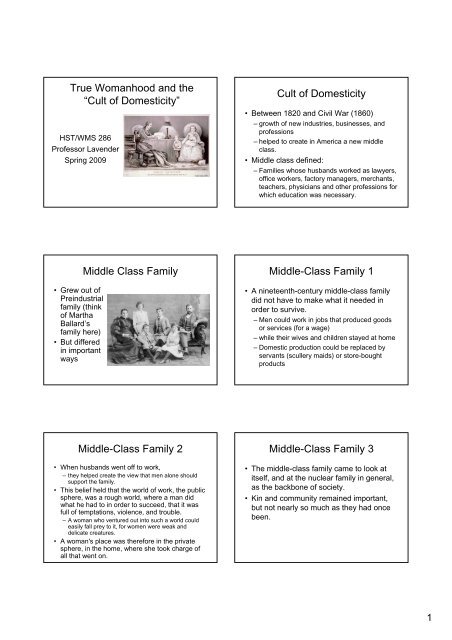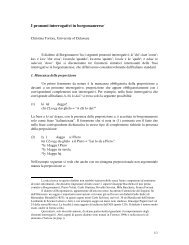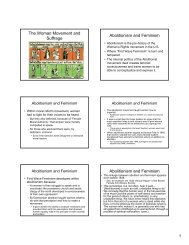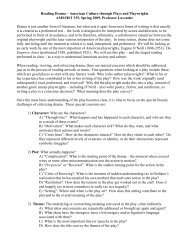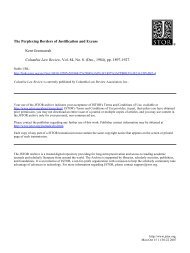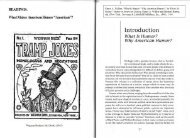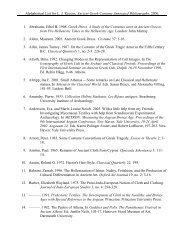True Womanhood and the “Cult of Domesticity” Cult of Domesticity ...
True Womanhood and the “Cult of Domesticity” Cult of Domesticity ...
True Womanhood and the “Cult of Domesticity” Cult of Domesticity ...
Create successful ePaper yourself
Turn your PDF publications into a flip-book with our unique Google optimized e-Paper software.
<strong>True</strong> <strong>Womanhood</strong> <strong>and</strong> <strong>the</strong><br />
<strong>“<strong>Cult</strong></strong> <strong>of</strong> <strong><strong>Domesticity</strong>”</strong><br />
HST/WMS 286<br />
Pr<strong>of</strong>essor Lavender<br />
Spring 2009<br />
• Grew out <strong>of</strong><br />
Preindustrial<br />
family (think<br />
<strong>of</strong> Martha<br />
Ballard’s<br />
family here)<br />
• But differed<br />
in important<br />
ways<br />
Middle Class Family<br />
Middle-Class Family 2<br />
• When husb<strong>and</strong>s went <strong>of</strong>f to work,<br />
– <strong>the</strong>y helped create <strong>the</strong> view that men alone should<br />
support <strong>the</strong> family.<br />
• This belief held that <strong>the</strong> world <strong>of</strong> work, <strong>the</strong> public<br />
sphere, was a rough world, where a man did<br />
what he had to in order to succeed, that it was<br />
full <strong>of</strong> temptations, violence, <strong>and</strong> trouble.<br />
– A woman who ventured out into such a world could<br />
easily fall prey to it, for women were weak <strong>and</strong><br />
delicate creatures.<br />
• A woman's place was <strong>the</strong>refore in <strong>the</strong> private<br />
sphere, in <strong>the</strong> home, where she took charge <strong>of</strong><br />
all that went on.<br />
<strong>Cult</strong> <strong>of</strong> <strong>Domesticity</strong><br />
• Between 1820 <strong>and</strong> Civil War (1860)<br />
– growth <strong>of</strong> new industries, businesses, <strong>and</strong><br />
pr<strong>of</strong>essions<br />
– helped to create in America a new middle<br />
class.<br />
• Middle class defined:<br />
– Families whose husb<strong>and</strong>s worked as lawyers,<br />
<strong>of</strong>fice workers, factory managers, merchants,<br />
teachers, physicians <strong>and</strong> o<strong>the</strong>r pr<strong>of</strong>essions for<br />
which education was necessary.<br />
Middle-Class Family 1<br />
• A nineteenth-century middle-class family<br />
did not have to make what it needed in<br />
order to survive.<br />
– Men could work in jobs that produced goods<br />
or services (for a wage)<br />
– while <strong>the</strong>ir wives <strong>and</strong> children stayed at home<br />
– Domestic production could be replaced by<br />
servants (scullery maids) or store-bought<br />
products<br />
Middle-Class Family 3<br />
• The middle-class family came to look at<br />
itself, <strong>and</strong> at <strong>the</strong> nuclear family in general,<br />
as <strong>the</strong> backbone <strong>of</strong> society.<br />
• Kin <strong>and</strong> community remained important,<br />
but not nearly so much as <strong>the</strong>y had once<br />
been.<br />
1
<strong>Cult</strong> <strong>of</strong> <strong>Domesticity</strong> <strong>and</strong> Middle-<br />
Class Family<br />
• A new ideal <strong>of</strong> womanhood <strong>and</strong> a new<br />
ideology about <strong>the</strong> home arose out <strong>of</strong> <strong>the</strong><br />
new attitudes about work <strong>and</strong> family.<br />
• Called <strong>the</strong> "cult <strong>of</strong> domesticity"<br />
• Found in women's magazines, advice<br />
books, religious journals, newspapers,<br />
fiction--everywhere in popular culture.<br />
• Provided a new view <strong>of</strong> women's duty <strong>and</strong><br />
role while cataloging <strong>the</strong> cardinal virtues <strong>of</strong><br />
true womanhood for a new age.<br />
Ideal <strong>Womanhood</strong><br />
• Ideal <strong>of</strong> womanhood had essentially four<br />
parts – four characteristics any good <strong>and</strong><br />
proper young woman or “true woman”<br />
should cultivate:<br />
–Piety<br />
–Purity<br />
– Submissiveness<br />
– <strong>Domesticity</strong><br />
2
Ideal <strong>Womanhood</strong>: Piety<br />
• In <strong>the</strong> nineteenth<br />
century it was believed<br />
that women had a<br />
particular propensity for<br />
religion.<br />
• The modern young<br />
woman <strong>of</strong> <strong>the</strong> 1820s<br />
<strong>and</strong> 30s was thought <strong>of</strong><br />
as a new Eve working<br />
with God to bring <strong>the</strong><br />
world out <strong>of</strong> sin through<br />
her suffering, through<br />
her pure, <strong>and</strong><br />
passionless love.<br />
Piety<br />
• Irreligion in<br />
females was<br />
considered "<strong>the</strong><br />
most revolting<br />
human<br />
characteristic".<br />
• Indeed, it was<br />
said that<br />
"godless, no<br />
woman, mo<strong>the</strong>r<br />
tho she be."<br />
Ideal <strong>Womanhood</strong>: Purity<br />
• To contemplate <strong>the</strong> loss <strong>of</strong> one's purity<br />
brought tears <strong>and</strong> hysteria to young<br />
women.<br />
• This made it a little difficult, <strong>and</strong> certainly a<br />
bit confusing to contemplate one's<br />
marriage, for in popular literature, <strong>the</strong><br />
marriage night was advertised as <strong>the</strong><br />
greatest night in a woman's life,<br />
– <strong>the</strong> night when she bestowed upon her<br />
husb<strong>and</strong> her greatest treasure, her virginity.<br />
Ideal <strong>Womanhood</strong>: Piety<br />
• But this was a specific<br />
variety <strong>of</strong> piety<br />
• The piety <strong>of</strong> <strong>the</strong> Second<br />
Great Awakening<br />
– Focused on <strong>the</strong> Protestant<br />
American experience<br />
• NOT Catholic or Jewish<br />
piety, which was equated<br />
with paganism<br />
– Simply ritual <strong>and</strong> cant<br />
Ideal <strong>Womanhood</strong>: Purity<br />
• Female purity was<br />
also highly revered.<br />
• Without sexual<br />
purity, a woman<br />
was no woman, but<br />
ra<strong>the</strong>r a lower form<br />
<strong>of</strong> being, a "fallen<br />
woman", unworthy<br />
<strong>of</strong> <strong>the</strong> love <strong>of</strong> her<br />
sex <strong>and</strong> unfit for<br />
<strong>the</strong>ir company.<br />
Ideal <strong>Womanhood</strong>: Purity<br />
• A woman must guard her “treasure” with her life.<br />
Despite any male attempt to assault her, she<br />
must remain pure <strong>and</strong> chaste. She must not give<br />
in, must not give her treasure into <strong>the</strong> wrong<br />
h<strong>and</strong>s.<br />
• Following is advice on how to protect oneself<br />
<strong>and</strong> one's treasure from Mrs. Eliza Farrar, author<br />
<strong>of</strong> The Young Woman's Friend:<br />
– "sit not with ano<strong>the</strong>r in a place that is too narrow; read<br />
not out <strong>of</strong> <strong>the</strong> same book; let not your eagerness to<br />
see anything induce you to place your head close to<br />
ano<strong>the</strong>r person's."<br />
3
Ideal <strong>Womanhood</strong>: Purity<br />
• American culture<br />
<strong>of</strong> <strong>the</strong> early<br />
nineteenth century<br />
underwent a purity<br />
fetish, such that it<br />
touched even <strong>the</strong><br />
language <strong>of</strong> <strong>the</strong><br />
day, popular<br />
decorating, <strong>and</strong><br />
myths.<br />
• Separate male<br />
<strong>and</strong> female<br />
authors on<br />
bookcases,<br />
unless, <strong>of</strong> course,<br />
<strong>the</strong>y were married<br />
to each o<strong>the</strong>r.<br />
• Also when myth <strong>of</strong><br />
stork bringing<br />
babies emerges.<br />
Purity <strong>Cult</strong>ure<br />
And cabbage patch babies.<br />
Purity <strong>Cult</strong>ure<br />
• There develops an American “language <strong>of</strong><br />
repression”<br />
– This when we began to talk about limbs for<br />
legs (even <strong>of</strong> chairs)<br />
– <strong>and</strong> white meat instead <strong>of</strong> breast meat (in<br />
fowl)<br />
• This when women began to decorate<br />
limbs chairs, pianos, tables<br />
– to cover with fabric so that one would not be<br />
reminded <strong>of</strong> legs.<br />
Ideal <strong>Womanhood</strong>:<br />
Submissiveness<br />
Mr. Stork bringing a baby.<br />
• This perhaps <strong>the</strong> most feminine <strong>of</strong> virtues.<br />
• Men were supposed to be religious,<br />
although not generally. Men were<br />
supposed to be pure, although one could<br />
really not expect it. But men never<br />
supposed to be submissive.<br />
• Men were to be movers, <strong>and</strong> doers--<strong>the</strong><br />
actors in life.<br />
• Women were to be passive byst<strong>and</strong>ers,<br />
submitting to fate, to duty, to God, <strong>and</strong> to<br />
men.<br />
4
• Women were warned<br />
that this was <strong>the</strong> order<br />
<strong>of</strong> things. The Young<br />
Ladies Book<br />
summarized : "It is<br />
certain that in whatever<br />
situation <strong>of</strong> life a<br />
woman is placed from<br />
her cradle to her grave,<br />
a spirit <strong>of</strong> obedience<br />
<strong>and</strong> submission,<br />
pliability <strong>of</strong> temper, <strong>and</strong><br />
humility <strong>of</strong> mind are<br />
required <strong>of</strong> her."<br />
Ideal <strong>Womanhood</strong>:<br />
Submissiveness<br />
Ideal <strong>Womanhood</strong>:<br />
Submissiveness<br />
• Female submissiveness<br />
<strong>and</strong> passivity guaranteed<br />
by clothing she was<br />
required to wear.<br />
• Tight corset lacing closed<br />
<strong>of</strong>f her lungs <strong>and</strong> pinched<br />
her inner organs toge<strong>the</strong>r.<br />
• Large numbers <strong>of</strong> under<br />
garments <strong>and</strong> <strong>the</strong> weight<br />
<strong>of</strong> over dresses limited<br />
her physical mobility.<br />
Hoop Skirts <strong>and</strong> Bustles Ideal <strong>Womanhood</strong>:<br />
Submissiveness<br />
• A number <strong>of</strong> popular<br />
sayings reiterate<br />
this:<br />
• "A woman has a<br />
head almost too<br />
small for intellect but<br />
just big enough for<br />
love.“<br />
• "<strong>True</strong> feminine<br />
genius is ever timid,<br />
doubtful, <strong>and</strong><br />
clingingly dependent;<br />
a perpetual<br />
childhood."<br />
Ideal <strong>Womanhood</strong>:<br />
Submissiveness<br />
• A true woman knew her place, <strong>and</strong> knew what<br />
qualities were wanted in her opposite.<br />
• George Burnap, The Sphere <strong>and</strong> Duties <strong>of</strong><br />
Woman: "She feels herself weak <strong>and</strong> timid. She<br />
needs a protector. She is in a measure<br />
dependent. She asks for wisdom, constancy,<br />
firmness, perseveredness, <strong>and</strong> she is willing to<br />
repay it all by <strong>the</strong> surrender <strong>of</strong> <strong>the</strong> full treasure <strong>of</strong><br />
her affection. Women despise in men everything<br />
like <strong>the</strong>mselves except a tender heart. It is<br />
enough that she is effeminate <strong>and</strong> weak; she<br />
does not want ano<strong>the</strong>r like herself."<br />
Ideal <strong>Womanhood</strong>: <strong>Domesticity</strong><br />
• Woman's place was in<br />
<strong>the</strong> home.<br />
• Woman's role was to be<br />
busy at those morally<br />
uplifting tasks aimed at<br />
maintaining <strong>and</strong> fulfilling<br />
her piety <strong>and</strong> purity.<br />
– Housework, childcare,<br />
decorative sewing <strong>and</strong><br />
embroidery<br />
5
Ideal <strong>Womanhood</strong>: <strong>Domesticity</strong><br />
• Housework was<br />
deemed such an<br />
uplifting task.<br />
• Godey's Lady’s<br />
Book: "There is<br />
more to be<br />
learned about<br />
pouring out tea<br />
<strong>and</strong> c<strong>of</strong>fee than<br />
most young ladies<br />
are willing to<br />
believe."<br />
Ideal <strong>Womanhood</strong>: <strong>Domesticity</strong><br />
• Much <strong>of</strong> women’s domestic labor focused<br />
on decoration – <strong>of</strong> both <strong>the</strong> home <strong>and</strong> <strong>of</strong><br />
<strong>the</strong> self<br />
• Victorian interiors <strong>and</strong> fashions were<br />
elaborate, labor-intensive, <strong>and</strong> costly<br />
– Women from <strong>the</strong> middle classes had to<br />
institute economies in order to have a well<br />
appointed wardrobe <strong>and</strong> home, learning to<br />
make <strong>the</strong> items <strong>the</strong>mselves<br />
Godey's Lady's Book, January<br />
1854<br />
Ideal <strong>Womanhood</strong>: <strong>Domesticity</strong><br />
• Needlework <strong>and</strong><br />
crafts were also<br />
approved activities<br />
which kept women<br />
in <strong>the</strong> home, busy<br />
about her tasks <strong>of</strong><br />
wifely duties <strong>and</strong><br />
childcare, keeping<br />
<strong>the</strong> home a cheerful,<br />
peaceful place<br />
which would attract<br />
men away from <strong>the</strong><br />
evils <strong>of</strong> <strong>the</strong> outer<br />
world.<br />
Nineteenth-Century Fashions<br />
Coiffure for Ball Costume, (Godey's Lady's Book, July 1860)<br />
6
Ideal <strong>Womanhood</strong>: <strong>Domesticity</strong><br />
• For <strong>the</strong> true woman, a woman's<br />
rights were as follows:<br />
The right to love whom<br />
o<strong>the</strong>rs scorn,<br />
The right to comfort <strong>and</strong> to<br />
mourn,<br />
The right to shed new joy on<br />
earth,<br />
The right to feel <strong>the</strong> soul's<br />
high worth,<br />
Such woman's rights a God<br />
will bless<br />
And crown <strong>the</strong>ir champions<br />
with success.<br />
Ideal <strong>Womanhood</strong>: <strong>Domesticity</strong><br />
• A new tradition <strong>of</strong><br />
“domestic experts”<br />
emerged to teach<br />
women <strong>the</strong> “fine art” <strong>of</strong><br />
keeping house.<br />
• The culture <strong>of</strong> this<br />
domestic artistry was in<br />
fact <strong>the</strong> “cult <strong>of</strong><br />
domesticity” at its<br />
highest point<br />
• The doyenne <strong>of</strong><br />
domesticity was<br />
Catharine Beecher (<strong>the</strong><br />
Martha Stewart <strong>of</strong> her<br />
day)<br />
What made “domestic<br />
arts” possible was <strong>the</strong><br />
availability <strong>of</strong> servants<br />
(or slaves) who would<br />
do <strong>the</strong> dirty work <strong>of</strong><br />
housework.<br />
Ideal <strong>Womanhood</strong>: <strong>Domesticity</strong><br />
• <strong>Cult</strong> <strong>of</strong> domesticity<br />
developed as <strong>the</strong> family<br />
lost its function as<br />
economic unit (with<br />
emergence <strong>of</strong> wage<br />
economy)<br />
• Many <strong>of</strong> links between<br />
family <strong>and</strong> community<br />
closed <strong>of</strong>f as work left<br />
home.<br />
• Women’s domestic work<br />
was reconfigured as nonproductive<br />
work.<br />
Domestic work –<br />
like child care –<br />
was romanticized<br />
into “fun” <strong>and</strong> “art”<br />
as <strong>the</strong> age <strong>of</strong><br />
sentimental<br />
childhood came<br />
into being.<br />
7
Ideal <strong>Womanhood</strong>: <strong>Domesticity</strong><br />
• Women were expected to uphold <strong>the</strong> values <strong>of</strong> stability,<br />
morality, democracy by making <strong>the</strong> home a special<br />
place, a refuge from <strong>the</strong> world where her husb<strong>and</strong> could<br />
escape from <strong>the</strong> highly competitive, unstable, immoral<br />
world <strong>of</strong> business <strong>and</strong> industry.<br />
Ideal <strong>Womanhood</strong>: <strong>Domesticity</strong><br />
• The home was to<br />
be <strong>the</strong> place where<br />
<strong>the</strong>y could do this,<br />
where <strong>the</strong>y could<br />
express <strong>the</strong>ir<br />
humanistic values,<br />
aes<strong>the</strong>tic values,<br />
love, honor, loyalty<br />
<strong>and</strong> faithfulness.<br />
Ideal <strong>Womanhood</strong>: <strong>Domesticity</strong><br />
• It was widely expected<br />
that in order to<br />
succeed in <strong>the</strong> world <strong>of</strong><br />
work, men had to<br />
adopt certain values<br />
<strong>and</strong> behaviors:<br />
materialism,<br />
aggression, vulgarity,<br />
hardness, rationality.<br />
But men also needed<br />
to develop ano<strong>the</strong>r<br />
side to <strong>the</strong>ir nature, a<br />
human side, an<br />
anticompetitive side.<br />
Ideal <strong>Womanhood</strong>: <strong>Domesticity</strong><br />
• The home was<br />
no longer a unit<br />
valued for its<br />
function in <strong>the</strong><br />
community, but<br />
ra<strong>the</strong>r for its<br />
isolation from <strong>the</strong><br />
community <strong>and</strong><br />
its service to its<br />
members.<br />
8
Ideal <strong>Womanhood</strong>: <strong>Domesticity</strong><br />
• Because <strong>the</strong> world<br />
<strong>of</strong> work was defined<br />
as male, <strong>the</strong> world<br />
<strong>of</strong> <strong>the</strong> home was<br />
defined as female.<br />
Part <strong>of</strong> its value lay<br />
in its leisurely<br />
aspects. Women<br />
increasingly<br />
became a<br />
complement to<br />
leisure, a kind <strong>of</strong><br />
useless but<br />
beautiful object, set<br />
<strong>of</strong>f by her special<br />
setting.<br />
The nineteenth century<br />
household was cluttered<br />
with beautiful, ornate<br />
objects – elaborate<br />
patterns in cloth covering<br />
walls, ornate furniture,<br />
pianos, paintings, brick-abrack.<br />
Colors were muted – dark<br />
<strong>and</strong> velvety – all to<br />
surround, darken, <strong>and</strong><br />
deepen <strong>the</strong> quiet <strong>of</strong> <strong>the</strong><br />
home, to accentuate <strong>the</strong><br />
s<strong>of</strong>tness, submissiveness,<br />
<strong>and</strong> leisure <strong>of</strong> <strong>the</strong> woman<br />
within it, <strong>the</strong> angel <strong>of</strong> <strong>the</strong><br />
house.<br />
H<br />
O<br />
P<br />
T<br />
O<br />
N<br />
H<br />
O<br />
U<br />
S<br />
E<br />
1<br />
9<br />
0<br />
0<br />
9
Ideal <strong>Womanhood</strong> & Separate Spheres<br />
• The characteristics <strong>of</strong> true manhood <strong>and</strong><br />
womanhood – <strong>and</strong> <strong>the</strong> separate spheres<br />
<strong>of</strong> male <strong>and</strong> female activity – were<br />
believed to have a biological basis.<br />
Ideal <strong>Womanhood</strong> & Separate<br />
Spheres<br />
• Contemporary ramifications for this<br />
definition <strong>of</strong> womanhood<br />
– We are still dealing with nineteenth century<br />
prescriptions <strong>of</strong> femininity <strong>and</strong> masculinity as<br />
opposites despite all intervening studies <strong>of</strong><br />
biology, culture, anthropology, etc.<br />
– We are still coping with definition woman's<br />
place as in <strong>the</strong> home, despite transformation<br />
economy from early industrial capitalism to<br />
post-industrial capitalism, <strong>and</strong> majority women<br />
in labor force outside home for past couple<br />
decades.<br />
Ideal <strong>Womanhood</strong> & Separate Spheres<br />
• This “scientific view” stated that<br />
– female<br />
• nurturance,<br />
• intuitive morality,<br />
• domesticity,<br />
• passivity,<br />
• <strong>and</strong> delicacy,<br />
– <strong>and</strong> male<br />
• rationality,<br />
• aggressiveness,<br />
• independence,<br />
• <strong>and</strong> toughness<br />
• were all due to <strong>the</strong>ir physical makeup <strong>and</strong><br />
biological differences between men <strong>and</strong> women.<br />
10
Ideal <strong>Womanhood</strong> & Separate Spheres<br />
•19 th -Century Science assumed that<br />
women were different from men.<br />
• This difference was that women were both<br />
physically <strong>and</strong> mentally inferior.<br />
• They built on 18 th -Century science ideas<br />
about women (as disorderly, as governed<br />
by wet <strong>and</strong> cold humors, etc.)<br />
Scientific Sexism <strong>and</strong> Menstruation<br />
• Scientists had no underst<strong>and</strong>ing about <strong>the</strong><br />
function <strong>of</strong> menstruation<br />
– Indeed, many scientists still don’t underst<strong>and</strong><br />
it<br />
• Menstruation was regarded as a periodic<br />
illness inflicted upon women. It was<br />
believed that menstruation could bring on<br />
temporary insanity in women.<br />
Ideal <strong>Womanhood</strong> & Separate Spheres<br />
• But <strong>the</strong>y also added new information about<br />
sexual <strong>and</strong> reproductive function <strong>and</strong> o<strong>the</strong>r<br />
19 th -century ideas like <strong>the</strong> study <strong>of</strong><br />
electricity to create a new science <strong>of</strong> sex<br />
difference that posited women’s inferiority.<br />
• This “sexual science” is commonly<br />
referred to as “scientific sexism,” very<br />
similar to “scientific racism”<br />
• Women were represented entirely by <strong>the</strong>ir<br />
reproductive function <strong>and</strong> organs<br />
Scientific Sexism<br />
• Scientists believed women were inferior<br />
because:<br />
– 1) Scientists argued that women were<br />
generally physically smaller than men.<br />
– 2) Scientists believed that women had less<br />
physical stamina than men because <strong>the</strong>y<br />
seemed to faint so much more<br />
– 3) Scientists knew that women menstruated,<br />
<strong>and</strong> <strong>the</strong>refore were believed to be physically<br />
incapacitated every month.<br />
Scientific Sexism <strong>and</strong><br />
Menstruation<br />
• Fur<strong>the</strong>rmore, it<br />
marked a “leak” in <strong>the</strong><br />
circulatory system<br />
where energy drained<br />
away <strong>and</strong> was<br />
wasted.<br />
• Clearly women were<br />
inferior to men who<br />
were not interrupted<br />
or incapacitated every<br />
month by illness.<br />
11
Scientific Sexism <strong>and</strong> Delicate Women<br />
• Women were<br />
deemed more<br />
delicate <strong>and</strong> weak<br />
than men because<br />
scientists believed<br />
that <strong>the</strong> female<br />
nervous system was<br />
– finer,<br />
– more irritable, <strong>and</strong><br />
– more prone to<br />
overstimulation <strong>and</strong><br />
fatigue<br />
• than <strong>the</strong> male<br />
nervous system.<br />
Scientific Sexism <strong>and</strong> Female Inferiority<br />
• Scientists posited that women had smaller brains than<br />
men.<br />
– Natural scientists measured cranial capacity <strong>and</strong> brain<br />
weight <strong>and</strong> correlated <strong>the</strong>se with intelligence.<br />
• At first scientists developed ratios based on size <strong>of</strong> brain to body<br />
weight.<br />
• But <strong>the</strong>y discovered that comparing female brain size to female body<br />
weight yielded a higher ratio that did comparing male brain size to<br />
male body weight.<br />
– So <strong>the</strong>y changed <strong>the</strong> correlation, <strong>and</strong> related brain weight to<br />
body height.<br />
– This time <strong>the</strong>y found that<br />
• <strong>the</strong> male brain produced .73 ounces <strong>of</strong> weight for each inch <strong>of</strong> height,<br />
• while <strong>the</strong> female brain produced only .70 ounces <strong>of</strong> weight for each<br />
inch <strong>of</strong> height.<br />
Scientific Sexism <strong>and</strong> Female Inferiority<br />
• By <strong>the</strong> way, <strong>the</strong> same<br />
type <strong>of</strong> study was used in<br />
<strong>the</strong> nineteenth century to<br />
show racial superiority<br />
<strong>and</strong> inferiority.<br />
• One <strong>of</strong> <strong>the</strong> world's<br />
foremost authorities, Carl<br />
Vogt, pr<strong>of</strong>essor <strong>of</strong> natural<br />
history at University <strong>of</strong><br />
Geneva said: "The grown<br />
up Negro partakes, as<br />
regards his intellectual<br />
faculties, <strong>of</strong> <strong>the</strong> nature <strong>of</strong><br />
<strong>the</strong> child, <strong>the</strong> female, <strong>and</strong><br />
<strong>the</strong> senile white."<br />
Scientific Sexism <strong>and</strong> Female Complaints<br />
• Physicians saw women<br />
as both <strong>the</strong> product <strong>and</strong><br />
<strong>the</strong> prisoner <strong>of</strong> her<br />
reproductive system.<br />
• The female uterus <strong>and</strong><br />
ovaries provided <strong>the</strong><br />
basis for her social role<br />
<strong>and</strong> her behavioral<br />
characteristics.<br />
• Physician William<br />
Clarke: "It was as if <strong>the</strong><br />
Almighty, in creating <strong>the</strong><br />
female sex, had taken<br />
<strong>the</strong> uterus <strong>and</strong> built up a<br />
woman around it."<br />
Scientific Sexism <strong>and</strong> Female Inferiority<br />
– There are two obvious problems with <strong>the</strong>se<br />
assumptions:<br />
• 1) In humans, brain size does not appear to correlate<br />
with ei<strong>the</strong>r body weight or height.<br />
– Over time, <strong>the</strong> human brain has become smaller although people<br />
are both taller <strong>and</strong> weigh more than in early times.<br />
• 2) There is no evidence that size, ei<strong>the</strong>r relative or<br />
absolute correlates with intelligence.<br />
Scientific Sexism <strong>and</strong> Female Inferiority<br />
• It was also said that <strong>the</strong> female<br />
brain was <strong>of</strong> an inferior <strong>and</strong> more<br />
primitive type than <strong>the</strong> male brain.<br />
• Much <strong>of</strong> this kind <strong>of</strong> interpretation<br />
came out <strong>of</strong> a pseudo science<br />
called phrenology.<br />
– Phrenology was <strong>the</strong> art <strong>of</strong> reading <strong>the</strong><br />
bumps <strong>and</strong> curves <strong>and</strong> shape <strong>of</strong> <strong>the</strong><br />
skull.<br />
– It was thought that <strong>the</strong> skull provided<br />
evidence <strong>of</strong> personality <strong>and</strong><br />
character, because different parts <strong>of</strong><br />
<strong>the</strong> skull housed different<br />
characteristics.<br />
• It was clear to phrenologists who<br />
studied cranium that "woman is a<br />
constantly growing child, <strong>and</strong> in<br />
<strong>the</strong> brain, as in so many o<strong>the</strong>r<br />
parts <strong>of</strong> her body, she conforms to<br />
her childish type."<br />
12
Scientific Sexism <strong>and</strong> Sexuality<br />
• In addition to beliefs about physical <strong>and</strong> mental<br />
inferiority, <strong>the</strong>re were certain "scientific" views<br />
<strong>of</strong> human sexuality which governed nineteenth<br />
century men <strong>and</strong> women. Essentially three<br />
ideas:<br />
– 1) Human body has only a limited amount <strong>of</strong><br />
energy. It is a closed system.<br />
• Expenditure <strong>of</strong> energy must, <strong>the</strong>refore, be closely<br />
regulated, because one activity would drain energy from<br />
ano<strong>the</strong>r.<br />
– 2) The sexual instinct is <strong>the</strong> most primitive instinct.<br />
• Phrenologists located it at <strong>the</strong> base <strong>of</strong> <strong>the</strong> brain.<br />
– 3) Sexual feelings were strong in men, but absent in<br />
women (certainly in “ladies”).<br />
Scientific Sexism <strong>and</strong> Sexuality<br />
• Passion in women was<br />
feared, because <strong>the</strong><br />
dem<strong>and</strong>s it would make<br />
on men were insatiable<br />
<strong>and</strong>, like a vampire, it was<br />
feared she would drain<br />
him <strong>of</strong> his life force.<br />
• Men were seen in a<br />
continual struggle with<br />
<strong>the</strong>ir passions. In <strong>the</strong><br />
interests <strong>of</strong> <strong>the</strong>ir own<br />
health, <strong>the</strong>y must control<br />
<strong>the</strong>m – but <strong>the</strong>y were not<br />
expected always to<br />
succeed.<br />
Scientific Sexism <strong>and</strong> Sexuality<br />
• Control over <strong>the</strong> female pubescent body<br />
was critical for women <strong>and</strong> <strong>the</strong> future <strong>of</strong> <strong>the</strong><br />
human race,<br />
– because if women did not develop some<br />
equilibrium in <strong>the</strong>ir body, <strong>the</strong>y would not only<br />
damage <strong>the</strong>mselves, causing untold pain,<br />
cancer, disease, a difficult menopause, <strong>and</strong><br />
early death, but <strong>the</strong>y would also damage <strong>the</strong>ir<br />
children.<br />
Scientific Sexism <strong>and</strong> Sexuality<br />
• Did women have sexuality? Or did “ladies”<br />
just suppress it?<br />
• Actually <strong>the</strong>re were conflicting opinions<br />
about female sexuality.<br />
– Women were ei<strong>the</strong>r voracious consumers <strong>of</strong><br />
male energy, or <strong>the</strong>y were passionless <strong>and</strong><br />
sexless.<br />
– The job <strong>of</strong> society was to make sure that<br />
women learned to be <strong>the</strong> latter.<br />
Scientific Sexism <strong>and</strong> Sexuality<br />
• Given attitudes about sexuality, puberty<br />
was considered critical period for both<br />
men <strong>and</strong> women, <strong>and</strong> <strong>the</strong>refore <strong>the</strong><br />
subject <strong>of</strong> much advice.<br />
• This was <strong>the</strong> time that men became<br />
strong <strong>and</strong> vigorous <strong>and</strong> women<br />
became timid <strong>and</strong> weak.<br />
Scientific Sexism <strong>and</strong> Sexuality<br />
•19 th -Century science believed that <strong>the</strong> traits<br />
<strong>of</strong> a child were inherited from his or her<br />
parents,<br />
– but <strong>the</strong> laws <strong>of</strong> heredity differed from those we<br />
now recognize.<br />
• They believed that men passed on to <strong>the</strong>ir children<br />
– <strong>the</strong>ir outer frame,<br />
– <strong>the</strong>ir musculature,<br />
– <strong>and</strong> <strong>the</strong>ir intellect.<br />
• Women passed on<br />
– <strong>the</strong> condition <strong>of</strong> <strong>the</strong>ir internal organs,<br />
– <strong>and</strong> <strong>the</strong>ir emotional stability or instability.<br />
13
Scientific Sexism <strong>and</strong> Sexuality<br />
• It was assumed that women had a lesser<br />
amount <strong>of</strong> energy, or "life force" than men.<br />
• Bodily fluids like blood were one measure<br />
<strong>of</strong> "life forces." (menstruation!)<br />
• Because <strong>the</strong> female reproductive system<br />
was more complex than <strong>the</strong> male, it was<br />
considered important for women to<br />
channel all energies into reproduction.<br />
• Therefore, women were discouraged from<br />
intellectual activity; that blood was needed<br />
for <strong>the</strong> development <strong>of</strong> <strong>the</strong> reproductive<br />
organs.<br />
Children’s Sexuality<br />
• The way to control adult sexuality was to<br />
nip in <strong>the</strong> bud <strong>the</strong> emergence <strong>of</strong> children’s<br />
sexual awakenings<br />
• There emerged a mass <strong>of</strong> literature –<br />
including that <strong>of</strong> W.S. Graham – focused<br />
on preventing masturbation in children<br />
– Through bl<strong>and</strong>, high-fiber foods<br />
– Harsh punishments for children who<br />
masturbated (including clitoridectomies)<br />
– And mechanical devices to prevent<br />
masturbation<br />
Scientific Sexism <strong>and</strong> Sexuality<br />
• Men, too, risked <strong>the</strong>ir health <strong>and</strong> <strong>the</strong> health <strong>of</strong><br />
society through wasting <strong>of</strong> <strong>the</strong>ir life force.<br />
• Tremendous social pressure for men to find a<br />
balance between exhausting “spermatorrhea”<br />
<strong>and</strong> damaging abstinence<br />
• Women’s indifference to sex served to protect<br />
men from <strong>the</strong>mselves<br />
• But men were also encouraged to find<br />
“acceptable” outlets to <strong>the</strong>ir sexual energies<br />
– Physical exertion or prostitutes, NOT masturbation<br />
Scientific Sexism <strong>and</strong> Sexuality<br />
• "The indulgence <strong>of</strong> illicit pleasures, says Dr. S. Pancoast,<br />
sooner or later is sure to entail <strong>the</strong> most loathsome<br />
diseases on <strong>the</strong>ir votaries. Among <strong>the</strong>se diseases are<br />
Gonorrhoea, Syphilis, Spermatorrhoea.., Satyriasis (a<br />
species <strong>of</strong> sexual madness, or a sexual diabolism, causing<br />
men to commit rape <strong>and</strong> o<strong>the</strong>r beastly acts <strong>and</strong> outrages,<br />
not only on women <strong>and</strong> children, but men <strong>and</strong> animals, as<br />
sodomy, pederasty, etc.), Nymphomania (causing women<br />
to assail every man <strong>the</strong>y meet, <strong>and</strong> supplicate <strong>and</strong> excite<br />
him to gratify <strong>the</strong>ir lustful passions, or who resort to means<br />
<strong>of</strong> sexual pollutions, which is impossible to describe without<br />
shuddering), toge<strong>the</strong>r with spinal diseases <strong>and</strong> many<br />
disorders <strong>of</strong> <strong>the</strong> most distressing <strong>and</strong> disgusting character<br />
filling <strong>the</strong> bones with rottenness, <strong>and</strong> eating away <strong>the</strong> flesh<br />
by gangrenous ulcers, until <strong>the</strong> patient dies, a horrible<br />
mass <strong>of</strong> putridity <strong>and</strong> corruption." -- from Searchlights on<br />
Health - The Science <strong>of</strong> Eugenics (1920)<br />
14
The Best Outlet = Marriage<br />
• The best outlet for male sexual energy<br />
was <strong>the</strong> marriage bed<br />
• Thus men <strong>and</strong> women were encouraged<br />
to marry in order to save <strong>the</strong> nation from<br />
<strong>the</strong> twin threats <strong>of</strong> male masturbatory<br />
dissipation <strong>and</strong> female hysteria.<br />
The Health Benefits <strong>of</strong> Marriage Illustrated Gender, Sexuality <strong>and</strong> <strong>the</strong> 19 th Century<br />
Gender, Sexuality <strong>and</strong> <strong>the</strong> 19 th<br />
Century<br />
• Economic development was valued as an outlet<br />
for sexual needs (kept men busy <strong>and</strong> outside <strong>the</strong><br />
home).<br />
• The language <strong>of</strong> <strong>the</strong> time:<br />
– "ejaculation" = "expenditure“<br />
– "semen" = "thrift“<br />
– "intercourse" = "connubial commerce“<br />
– "womb" <strong>and</strong> “virginity” = "treasure“<br />
– "child birth" = "labor“<br />
• The nineteenth century developed a whole<br />
vocabulary which demonstrates how<br />
closely sexual <strong>and</strong> economic metaphors<br />
overlapped in <strong>the</strong>ir minds.<br />
• Mining, railroad building, canal digging, all<br />
held sexual overtones <strong>of</strong> male mastery<br />
over female nature.<br />
15


